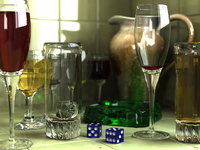Rendering (computer graphics)

Have you ever drawn a picture with crayons or markers? Think of rendering like drawing a picture on a computer. It's a way to create images or animations that look like they are real on the screen.
Basically, rendering starts with a three-dimensional (3D) model of an object or scene made up of points (vertices) connected by lines (edges) and faces (polygons). These 3D models can be created using special software or scanned from the real world using a 3D scanner.
Once we have a 3D model, we need to decide how it will look on the screen. This is where we add colors, textures, and lighting effects. We give the object or scene a virtual material, such as wood or metal, and choose how light will reflect off of it.
After we've set up these parameters, we're ready to start rendering. In order to create a 2D image, the computer "renders" the 3D model by simulating the lighting and shadowing effects on each polygon. This can take a lot of computing power and time, depending on the complexity of the model and the number of polygons.
Once the rendering process is complete, the computer spits out a 2D image or animation that looks like a photo or video of the 3D model. This image can be further edited using image editing software to add other effects like lens flares or color correction before it's ready to be shared with the world.
So, to sum it up: rendering is like drawing on a computer, but instead of using crayons or markers, we use a 3D model and a computer program to make it look real on the screen.
Basically, rendering starts with a three-dimensional (3D) model of an object or scene made up of points (vertices) connected by lines (edges) and faces (polygons). These 3D models can be created using special software or scanned from the real world using a 3D scanner.
Once we have a 3D model, we need to decide how it will look on the screen. This is where we add colors, textures, and lighting effects. We give the object or scene a virtual material, such as wood or metal, and choose how light will reflect off of it.
After we've set up these parameters, we're ready to start rendering. In order to create a 2D image, the computer "renders" the 3D model by simulating the lighting and shadowing effects on each polygon. This can take a lot of computing power and time, depending on the complexity of the model and the number of polygons.
Once the rendering process is complete, the computer spits out a 2D image or animation that looks like a photo or video of the 3D model. This image can be further edited using image editing software to add other effects like lens flares or color correction before it's ready to be shared with the world.
So, to sum it up: rendering is like drawing on a computer, but instead of using crayons or markers, we use a 3D model and a computer program to make it look real on the screen.
Related topics others have asked about:
